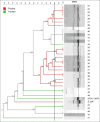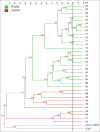Effectiveness of six molecular typing methods as epidemiological tools for the study of Salmonella isolates in two Colombian regions
- PMID: 32095053
- PMCID: PMC6989315
- DOI: 10.14202/vetworld.2019.1998-2006
Effectiveness of six molecular typing methods as epidemiological tools for the study of Salmonella isolates in two Colombian regions
Abstract
Aim: The aim of this study was the genotypic characterization of the strains of Salmonella spp. isolated from broiler chickens and humans with gastroenteritis from two regions of Colombia, by BOXA1R-polymerase chain reaction (PCR) and random amplification of polymorphic DNA (RAPD)-PCR methods.
Materials and methods: Forty-nine strains of Salmonella were assessed, 15 from poultry farms in Santander region, and 34 from Tolima region isolated from poultry farms (n=24) and the stool samples of people with gastroenteritis (n=10). BOXA1R primers were selected for repetitive element-based PCR (REP-PCR) and five arbitrary primers, namely, GTG 5, OPB 15, OPP 16, OPS 11, and P 1254 were used for RAPD-PCR to generate DNA fingerprints from the isolates. Fingerprint data from each typing method were under composite analysis and the diversity of the data was analyzed by grouping (clustering). The dendrogram was generated by the unweighted group method with analysis of the arithmetic mean based on the Dice similarity coefficient. In addition, Simpson's index was evaluated to discriminate the power of the methods.
Results: OPP 16 primer and composite analysis proved to be superior compared to other REP-PCR typing methods. The best discriminatory index was observed when GTG 5 (0.92) and OPP 16 (0.85) primers were used alone or combined with RAPD-PCR and BOX-PCR (0.99).
Conclusion: This study indicated that OPP 16 and GTG 5 primers provide suitable molecular typing results for the discrimination of the genetic relationship among Salmonella spp. isolates and may be useful for epidemiological studies.
Keywords: dendrogram; serotyping; typing methods.
Copyright: © Lozano-Villegas, et al.
Figures




Similar articles
-
The effective differentiation of Salmonella isolates using four PCR-based typing methods.J Appl Microbiol. 2015 Jun;118(6):1530-40. doi: 10.1111/jam.12805. Epub 2015 Apr 21. J Appl Microbiol. 2015. PMID: 25809397
-
Comparison of five repetitive-sequence-based PCR typing methods for molecular discrimination of Salmonella enterica isolates.J Clin Microbiol. 2005 Aug;43(8):3615-23. doi: 10.1128/JCM.43.8.3615-3623.2005. J Clin Microbiol. 2005. PMID: 16081887 Free PMC article.
-
Molecular characterization of Salmonella isolates by REP-PCR and RAPD analysis.Infect Genet Evol. 2009 May;9(3):322-7. doi: 10.1016/j.meegid.2007.12.003. Epub 2007 Dec 23. Infect Genet Evol. 2009. PMID: 18243815
-
RAPD Fingerprinting and Genetic Diversity of Salmonella Spp. Isolated from Broiler and Layer Flocks in Karbala, Iraq.Arch Razi Inst. 2021 Nov 30;76(5):1363-1370. doi: 10.22092/ari.2021.356000.1759. eCollection 2021 Nov. Arch Razi Inst. 2021. PMID: 35355767 Free PMC article.
-
Molecular typing of Salmonella spp isolated from food handlers and animals in Nigeria.Int J Mol Epidemiol Genet. 2011 Jan 1;2(1):73-7. Epub 2010 Dec 28. Int J Mol Epidemiol Genet. 2011. PMID: 21537404 Free PMC article.
Cited by
-
Virulence genes identification in Salmonella enterica isolates from humans, crocodiles, and poultry farms from two regions in Colombia.Vet World. 2023 Oct;16(10):2096-2103. doi: 10.14202/vetworld.2023.2096-2103. Epub 2023 Oct 14. Vet World. 2023. PMID: 38023281 Free PMC article.
-
Molecular identification of fluoroquinolone resistance in Salmonella spp. isolated from broiler farms and human samples obtained from two regions in Colombia.Vet World. 2021 Jul;14(7):1767-1773. doi: 10.14202/vetworld.2021.1767-1773. Epub 2021 Jul 7. Vet World. 2021. PMID: 34475696 Free PMC article.
References
-
- Eng S.K, Pusparajah P, Ab Mutalib N.S, Ser H.L, Chan K.G, Lee L.H. Salmonella:A review on pathogenesis, epidemiology and antibiotic resistance. Front. Life Sci. 2015;8(3):284–293.
-
- Silva C, Betancor L, García C, Astocondor L, Hinostroza N, Bisio J, Rivera J, Perezgasga L, Escanda V, Yim L, Jacobs J, García-del Portillo F, Chabalgoity J, Puente J.L. Characterization of Salmonellaenterica isolates causing bacteremia in Lima, Peru, using multiple typing methods. PloS One. 2017;12(12):e0189946–e0189946. - PMC - PubMed
-
- Wise M.G, Siragusa G.R, Plumblee J, Healy M, Cray P.J, Seal B.S. Predicting Salmonellaenterica serotypes by repetitive sequence-based PCR. J. Microbiol. Methods. 2009;76(1):18–24. - PubMed
-
- Allerberger F, Liesegang A, Grif K, Khaschabi D, Prager R, Danzl J, Höck F, Öttl J, Dierich M.P, Berghold C, Neckstaller I, Tschäpe H, Fisher I. Occurrence of Salmonellaenterica serovar Dublin in Austria. Wien. Med. Wochenschr. 2003;153(7-8):148–152. - PubMed
LinkOut - more resources
Full Text Sources
Miscellaneous
